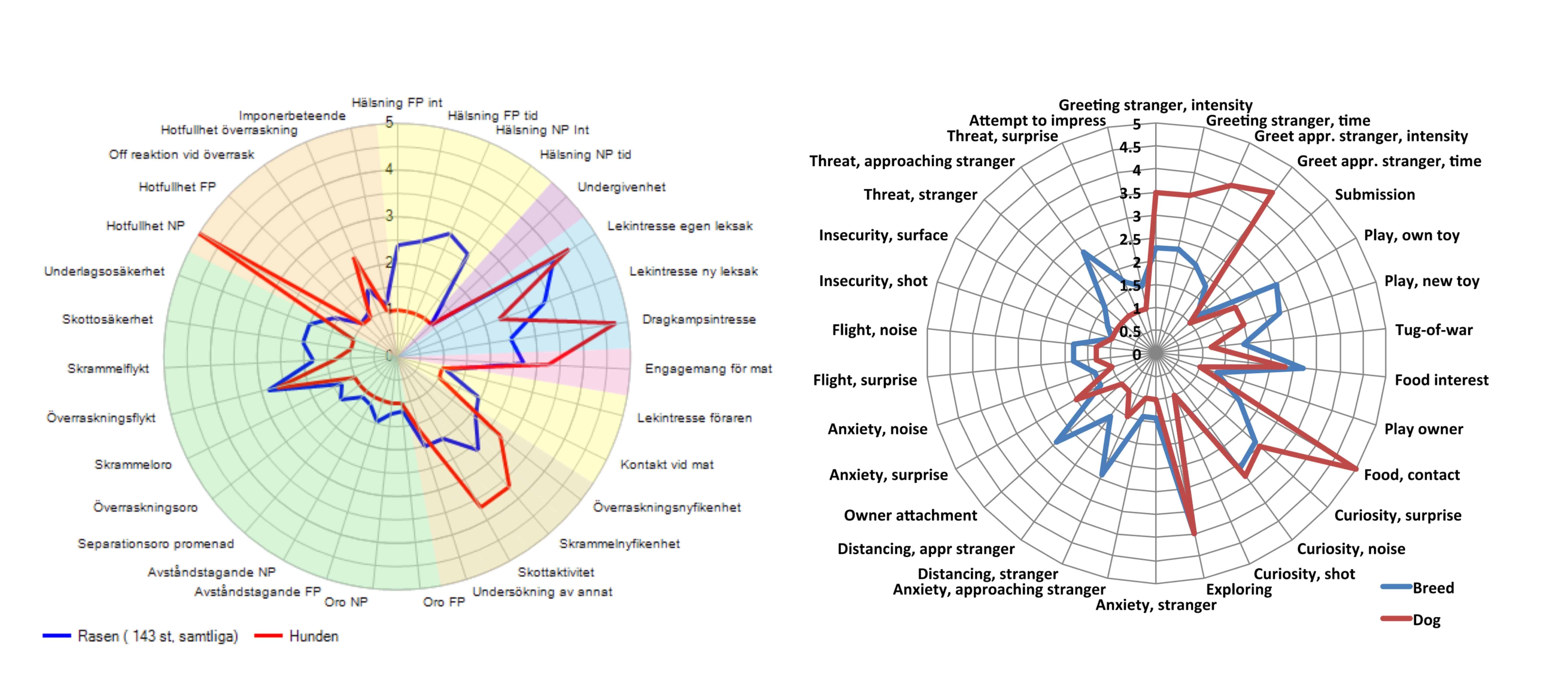The Nordic Dog Mentality Assessment (DMA) tests are designed to evaluate a dog’s temperament and behaviour in various controlled situations. Called MH (Mental Behaviour Dog), BPH (Behaviour and Personality Assessment) or MT/FA (Mentality Test), the tests consist of a series of “moments,” or scenarios, that measure how a dog reacts to different stimuli, providing a comprehensive look into its personality.
Although MH, BPH and MT/FA are separate tests, they measure similar traits and behaviours. Some of the key moments in these tests include:
Playfulness: A dog’s willingness to engage in play, especially with a stranger, offers valuable insight into its openness and confidence. Playfulness reveals how relaxed the dog feels in unfamiliar situations and around new people. A playful dog is often more adaptable, social, and less stressed when exposed to novel environments. This is an important trait, particularly for family pets, as it indicates a dog’s ability to form bonds easily and enjoy social interactions, promoting a positive relationship between the dog and its owners or trainers.
When a dog shows eagerness to engage in pulling or interactive play, such as tug-of-war, it demonstrates not only its energy levels but also its drive and motivation. This willingness is especially important in working dogs or dogs used in sports, as it reflects their determination, focus, and cooperative nature. For service dogs, search-and-rescue dogs, or even highly active family pets, these traits are essential for maintaining motivation during tasks, training, or play. It shows their resilience and mental sharpness, making them suitable for roles that require persistence and physical engagement.
Social behaviour: How the dog reacts to strangers – friendly, indifferent, or cautious. This moment shows a dog’s sociability and level of comfort with unfamiliar humans.
Reaction to sudden stimuli: In this test, the dog is exposed to unexpected events like sudden noises or objects appearing. The way a dog reacts helps assess its sensitivity to environmental changes and ability to handle stress. A dog that quickly recovers after being startled shows resilience and adaptability, key traits for both everyday life and working roles.
In contrast, a dog that reacts with anxiety or avoidance may be more sensitive to stress, possibly needing extra training or careful handling. As a breeder, I will exclude dogs like this from breeding. The ability to stay calm and recover quickly is crucial for dogs in high-pressure roles, but maybe more importantly, as family pets and companions.
Courage and fearfulness: A dog’s courage is evaluated by presenting situations that challenge its confidence. These might include encountering a stranger dressed in unusual clothing or facing unfamiliar objects, such as large, oddly shaped items that appear suddently. The way a dog responds in these scenarios helps assess its bravery and willingness to approach or investigate something potentially threatening. A courageous dog may cautiously but confidently approach the stimulus, indicating that it can handle fear-inducing situations and recover quickly from stress.
Conversely, a more fearful dog might avoid the object or person, showing signs of hesitation or retreat. While some level of fear is natural, especially in situations that seem strange or intimidating, the degree of fearfulness displayed can give valuable insight into the dog’s emotional resilience. For working or service dogs, courage is crucial, as they may face high-pressure situations where confidence and quick decision-making are needed.
Curiosity: The dog’s curiosity is another important trait measured in these tests. When presented with new or unusual objects, sounds, or situations, the dog’s interest in exploring or investigating them reflects its openness and adventurous personality. A curious dog will approach and examine the new stimulus, demonstrating an eagerness to learn about its environment. This trait is linked to problem-solving abilities, adaptability, and a positive attitude toward new experiences – qualities that are highly valued in both family pets and working dog
For most dogs, a balance between caution and curiosity is desirable, showing the dog can assess risk without being overwhelmed by fear. For many working dogs, one would like more curiosity than cautiousness, and breeders of working dogs would often choose these dogs as their pick of litter for working and breeding.
Personality Traits and Heritability
Swedish ethologist Kenth Svartberg and colleagues have studied the results from these tests for over two decades and found that several key traits, such as playfulness, sociability, curiosity, and courage, are highly heritable. The research has shown that these traits can and will be passed down from generation to generation, making them crucial factors for breeders who want to maintain or improve their breed’s mental health and personality.
Svartberg’s work has significantly impacted dog breeding practices in the Nordic countries. Breeders can now use these tools to select dogs with desirable personality traits, such as calmness, confidence, and sociability while avoiding breeding dogs with excessive fearfulness or aggression. This research has led to more informed and responsible breeding decisions, resulting in dogs that are mentally stable and well-suited to their roles – whether they are working dogs, show dogs, or family companions.
Svartberg’s findings have also expanded the scientific understanding of animal behaviour genetics, illustrating inheritance’s important role in shaping a dog’s temperament. This means that a dog’s mentality is not just influenced by its environment but also by the traits passed down from its parents, making these tests a powerful tool for improving a breed’s overall mental health.
A BPH Test Result Explained
Airedale Nani – BPH: https://www.youtube.com/watch?v=R3VzzgVbtDo
Airedale Vips – BPH: https://www.youtube.com/watch?v=5Sty72Ar514
Airedale Iagan – BPH: https://www.youtube.com/watch?v=UcpmfMp4ArM
Ridgeback Navi – BPH: https://www.youtube.com/watch?v=t4jVSIAYQUU
Ridgeback Buck – BPH: https://www.youtube.com/watch?v=Vxi7d5ot2L4
Airedale Uno – MH: https://www.youtube.com/watch?v=hVJFSlTADyg
Ridgeback Buck – MT: https://www.youtube.com/watch?v=yv9rtELZmP4&t=8s
Airedale Allie – MT: https://www.youtube.com/watch?v=nJzs3Vn2Y6s
Ridgeback Buck – FA: https://www.youtube.com/watch?v=0yf4SQQTDYo
– – – – –
Note: This text was initiated and written by the author, with AI tools used to enhance language and readability.
– – – – –
References:
- Svartberg & Forkman (2002). Personality traits in the domestic dog (Canis familiaris). https://www.sciencedirect.com/science/article/abs/pii/S0168159102001211
- Svartberg (2002). Shyness–boldness predicts performance in working dogs. https://www.sciencedirect.com/science/article/pii/S016815910200120X
- Svartberg (2005). A comparison of behaviour in test and in everyday life: Evidence of three consistent boldness-related personality traits in dogs. https://www.sciencedirect.com/science/article/abs/pii/S0168159104002187
- Behavior and Personality Assessment in Dogs (BPH). https://www.skk.se/en/dog-health–breeding/bph–behavior-and-personality-assessment-in-dogs/
- Mental Behaviour Dog (MH). https://brukshundklubben.se/media/2zojm1xm/anvisningar_mentalbeskrivning_hund_engelska_2017.pdf
Published on the Facebook group European Airedale breeders, September 26, 2024 (link)



